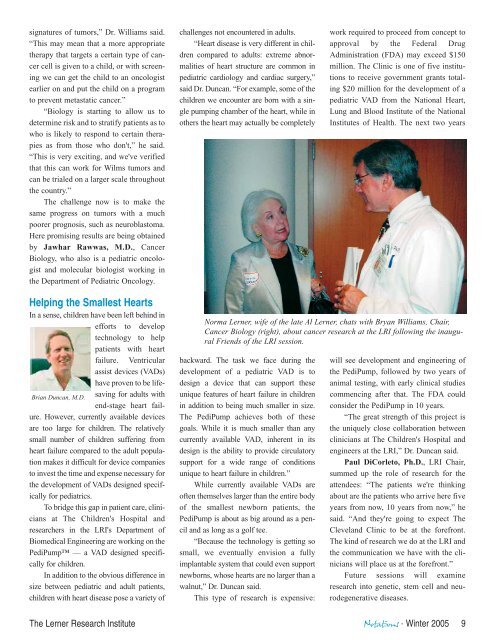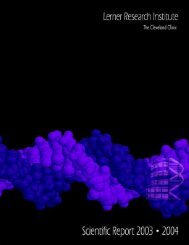The Lerner Research Institute Notations - Cleveland Clinic Lerner ...
The Lerner Research Institute Notations - Cleveland Clinic Lerner ...
The Lerner Research Institute Notations - Cleveland Clinic Lerner ...
- No tags were found...
You also want an ePaper? Increase the reach of your titles
YUMPU automatically turns print PDFs into web optimized ePapers that Google loves.
signatures of tumors,” Dr. Williams said.“This may mean that a more appropriatetherapy that targets a certain type of cancercell is given to a child, or with screeningwe can get the child to an oncologistearlier on and put the child on a programto prevent metastatic cancer.”“Biology is starting to allow us todetermine risk and to stratify patients as towho is likely to respond to certain therapiesas from those who don't,” he said.“This is very exciting, and we've verifiedthat this can work for Wilms tumors andcan be trialed on a larger scale throughoutthe country.”<strong>The</strong> challenge now is to make thesame progress on tumors with a muchpoorer prognosis, such as neuroblastoma.Here promising results are being obtainedby Jawhar Rawwas, M.D., CancerBiology, who also is a pediatric oncologistand molecular biologist working inthe Department of Pediatric Oncology.challenges not encountered in adults.“Heart disease is very different in childrencompared to adults: extreme abnormalitiesof heart structure are common inpediatric cardiology and cardiac surgery,”said Dr. Duncan. “For example, some of thechildren we encounter are born with a singlepumping chamber of the heart, while inothers the heart may actually be completelywork required to proceed from concept toapproval by the Federal DrugAdministration (FDA) may exceed $150million. <strong>The</strong> <strong>Clinic</strong> is one of five institutionsto receive government grants totaling$20 million for the development of apediatric VAD from the National Heart,Lung and Blood <strong>Institute</strong> of the National<strong>Institute</strong>s of Health. <strong>The</strong> next two yearsHelping the Smallest HeartsIn a sense, children have been left behind inefforts to developtechnology to helppatients with heartfailure. Ventricularassist devices (VADs)have proven to be lifesavingfor adults withBrian Duncan, M.D.end-stage heart failure.However, currently available devicesare too large for children. <strong>The</strong> relativelysmall number of children suffering fromheart failure compared to the adult populationmakes it difficult for device companiesto invest the time and expense necessary forthe development of VADs designed specificallyfor pediatrics.To bridge this gap in patient care, cliniciansat <strong>The</strong> Children's Hospital andresearchers in the LRI's Department ofBiomedical Engineering are working on thePediPump — a VAD designed specificallyfor children.In addition to the obvious difference insize between pediatric and adult patients,children with heart disease pose a variety ofNorma <strong>Lerner</strong>, wife of the late Al <strong>Lerner</strong>, chats with Bryan Williams, Chair,Cancer Biology (right), about cancer research at the LRI following the inauguralFriends of the LRI session.backward. <strong>The</strong> task we face during thedevelopment of a pediatric VAD is todesign a device that can support theseunique features of heart failure in childrenin addition to being much smaller in size.<strong>The</strong> PediPump achieves both of thesegoals. While it is much smaller than anycurrently available VAD, inherent in itsdesign is the ability to provide circulatorysupport for a wide range of conditionsunique to heart failure in children.”While currently available VADs areoften themselves larger than the entire bodyof the smallest newborn patients, thePediPump is about as big around as a penciland as long as a golf tee.“Because the technology is getting sosmall, we eventually envision a fullyimplantable system that could even supportnewborns, whose hearts are no larger than awalnut,” Dr. Duncan said.This type of research is expensive:will see development and engineering ofthe PediPump, followed by two years ofanimal testing, with early clinical studiescommencing after that. <strong>The</strong> FDA couldconsider the PediPump in 10 years.“<strong>The</strong> great strength of this project isthe uniquely close collaboration betweenclinicians at <strong>The</strong> Children's Hospital andengineers at the LRI,” Dr. Duncan said.Paul DiCorleto, Ph.D., LRI Chair,summed up the role of research for theattendees: “<strong>The</strong> patients we're thinkingabout are the patients who arrive here fiveyears from now, 10 years from now,” hesaid. “And they're going to expect <strong>The</strong><strong>Cleveland</strong> <strong>Clinic</strong> to be at the forefront.<strong>The</strong> kind of research we do at the LRI andthe communication we have with the clinicianswill place us at the forefront.”Future sessions will examineresearch into genetic, stem cell and neurodegenerativediseases.<strong>The</strong> <strong>Lerner</strong> <strong>Research</strong> <strong>Institute</strong> <strong>Notations</strong> · Winter 2005 9
















